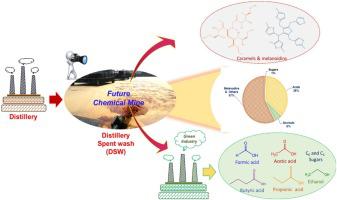Journal of Water Process Engineering ( IF 6.3 ) Pub Date : 2020-05-29 , DOI: 10.1016/j.jwpe.2020.101353 Pankaj A. Shinde , Tejas M. Ukarde , Preeti H. Pandey , Hitesh S. Pawar

|
The ethanol distillery generates a huge quantum of undesirable dark brown coloured wastewater called “Distillery Spent Wash” (DSW) or “Vinasse” which has high COD and BOD. Presently, the disposal of DSW sustainably and efficiently is a major scientific, engineering, economic and environmental challenge in front of the distillery industry. In the present manuscript, a comprehensive approach has been made to elucidate the physicochemical properties of DSW and explored its potential for the production of commodity chemicals. The characterization of DSW samples collected from different distilleries throughout India was done by various analytical techniques such as HPLC, elemental analysis, TDS, TSS and ash content etc. Typically, the COD of DSW samples was found in the range of 1, 10,000 to 2, 05,000 ppm (parts per million) due to the variable composition of dissolved organic compounds. Of the total COD, (a) 1-2% is contributed by sugars like xylose, glucose and sucrose, (b) 30-36% by carboxylic acids like formic acid, acetic acid, propionic acid and butyric acid, (c) 5-6 % by alcohol like ethanol and (d) 50-57% by melanoidins and caramels. The estimated statistics based on the present study depicted that DSW can be a potential chemical pool for the production of commodity chemicals. Assessment of DSW for the production of commodity chemicals could appreciably contribute to both the economic and environmental aspects of distillery wastewater management. However, future distillery can be directed as a multiproduct industry for the production of commodity chemicals from distillery wastewater.
中文翻译:

酒厂废洗:下一代可持续酿酒厂的新兴化学品库
乙醇蒸馏厂会产生大量不受欢迎的深棕色废水,称为“蒸馏厂废液”(DSW)或“酒糟”,其COD和BOD较高。当前,可持续和有效地处置DSW是摆在酿酒行业面前的重大科学,工程,经济和环境挑战。在本手稿中,已经采取了一种综合方法来阐明DSW的理化特性,并探索了其在生产日用化学品方面的潜力。通过各种分析技术(例如HPLC,元素分析,TDS,TSS和灰分等)对从印度不同酒厂收集的DSW样品进行表征。通常,发现DSW样品的COD范围为1,10,000至2 ,05,由于溶解的有机化合物的组成可变,因此浓度为000 ppm(百万分之一)。在总化学需氧量中,(a)1-2%由木糖,葡萄糖和蔗糖等糖类贡献;(b)30-36%由甲酸,乙酸,丙酸和丁酸等羧酸贡献;(c)5酒精(如乙醇)的含量为-6%,黑素和焦糖的含量为(d)50-57%。根据本研究的估计统计数据表明,DSW可能是用于生产商品化学品的潜在化学品库。对用于商品化学品生产的DSW的评估可对酿酒厂废水管理的经济和环境方面做出重大贡献。但是,未来的蒸馏厂可以作为一种多产品产业来利用蒸馏厂废水生产商品化学品。在总化学需氧量中,(a)1-2%由木糖,葡萄糖和蔗糖等糖类贡献;(b)30-36%由甲酸,乙酸,丙酸和丁酸等羧酸贡献;(c)5酒精(如乙醇)的含量为-6%,黑素和焦糖的含量为(d)50-57%。根据本研究的估计统计数据表明,DSW可能是用于生产商品化学品的潜在化学品库。对用于商品化学品生产的DSW的评估可对酿酒厂废水管理的经济和环境方面做出重大贡献。但是,未来的蒸馏厂可以作为一种多产品产业来利用蒸馏厂废水生产商品化学品。在总化学需氧量中,(a)1-2%由木糖,葡萄糖和蔗糖等糖类贡献;(b)30-36%由甲酸,乙酸,丙酸和丁酸等羧酸贡献;(c)5酒精(如乙醇)的含量为-6%,黑素和焦糖的含量为(d)50-57%。根据本研究的估计统计数据表明,DSW可能是用于生产商品化学品的潜在化学品库。对用于商品化学品生产的DSW的评估可对酿酒厂废水管理的经济和环境方面做出重大贡献。但是,未来的蒸馏厂可以作为一种多产品产业来利用蒸馏厂废水生产商品化学品。丙酸和丁酸,(c)酒精(如乙醇)占5-6%,(d)黑色素和焦糖占50-57%。根据本研究的估计统计数据表明,DSW可能是用于生产商品化学品的潜在化学品库。对用于商品化学品生产的DSW的评估可对酿酒厂废水管理的经济和环境方面做出重大贡献。但是,未来的蒸馏厂可以作为一种多产品产业来利用蒸馏厂废水生产商品化学品。丙酸和丁酸,(c)酒精(如乙醇)占5-6%,(d)黑色素和焦糖占50-57%。根据本研究的估计统计数据表明,DSW可能是用于生产商品化学品的潜在化学品库。对用于商品化学品生产的DSW的评估可对酿酒厂废水管理的经济和环境方面做出重大贡献。但是,未来的蒸馏厂可以作为一种多产品产业来利用蒸馏厂废水生产商品化学品。对用于商品化学品生产的DSW的评估可对酿酒厂废水管理的经济和环境方面做出重大贡献。但是,未来的蒸馏厂可以作为一种多产品产业来利用蒸馏厂废水生产商品化学品。对用于商品化学品生产的DSW的评估可对酿酒厂废水管理的经济和环境方面做出重大贡献。但是,未来的蒸馏厂可以作为一种多产品产业来利用蒸馏厂废水生产商品化学品。











































 京公网安备 11010802027423号
京公网安备 11010802027423号